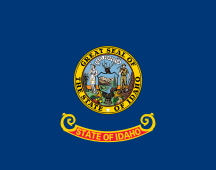Loading AI tools
Official flag and government emblem of the U.S. state of Idaho From Wikipedia, the free encyclopedia
The seal of the Territory of Idaho was adopted in 1863 and redrawn several times before statehood in 1890. The first state Great Seal was designed in the 1890s by Emma Edwards Green, the only woman to design a U.S. state seal. That seal was used until 1957, when the seal was slightly redrawn by Paul B. Evans and the Caxton Printers, Ltd. at the request of the state government, in order to add more anthropocentric elements to the centered shield.
 | |
| Use | Civil and state flag |
|---|---|
| Proportion | 26:33 (official) |
| Adopted | March 15, 1907 (modified 1927 and 1957) |
| Design | A state seal above the words "State of Idaho" in gold letters on a red and gold band on a blue field. |
The flag of the state of Idaho was adopted on March 15, 1927, and consists of the state seal on a field of blue. The words "State of Idaho" appear in gold letters on a red and gold band below the seal. According to the official description of the flag, there should also be a fringe of gold around the edges.[1] The official proportions of the flag, 26:33, are unique in the world, although many reproductions use more common ratios like 2:3
The seal depicts a miner and a woman representing equality, liberty and justice. The symbols on the seal represent some of Idaho's natural resources: mines, forests, farmland and wildlife.
The current seal contains the text "Great Seal of the State of Idaho" in the outer ring, with the star that signifies a new light in the galaxy of states. The inner ring contains a banner with the Latin motto, Esto perpetua ("Let it be perpetual" or "It is forever").[2] A woman (signifying justice) and a man (dressed as a miner) support a shield. The miner represents the chief industry of the state at the time of statehood.
Inside, the shield bears images symbolic of the state. The pine tree in the foreground refers to Idaho's immense timber interests. The husbandman plowing on the left side of the shield, together with the sheaf of grain beneath the shield, are emblematic of Idaho's agricultural resources, while the two cornucopias, or horns of plenty, refer to the horticultural. Idaho has a game law, which protects the elk and moose; an elk's head rises above the shield. The state flower, the wild syringa or mock orange, grows tall at the woman's right, while the ripened wheat grows as high as her shoulder. The river depicted in the shield is the Snake or Shoshone River.
In 1957, the seal was slightly redrawn by Paul B. Evans and the Caxton Printers, Ltd. at the request of the state government, in order to add more anthropocentric elements to the centered shield.[3]
In 2001, the North American Vexillological Association surveyed its members on the designs of all 72 Canadian provincial, U.S. state and U.S. territorial flags, combined. Idaho finished in the bottom ten, finishing 64th out of the 72.[4][5]
During much of the 1920s, there was only one known Idahoan state flag in existence, designed by the state's adjutant general and in possession of the governor of Idaho, traveling with him as he went abroad.[6]
Seamless Wikipedia browsing. On steroids.
Every time you click a link to Wikipedia, Wiktionary or Wikiquote in your browser's search results, it will show the modern Wikiwand interface.
Wikiwand extension is a five stars, simple, with minimum permission required to keep your browsing private, safe and transparent.